If you’re just starting out with fishkeeping, I highly recommend the Cory catfish, or Corydoras. These fish are peaceful and easy to care for, making them great for any beginner’s aquarium. They help keep the tank clean by eating leftovers. Plus, they live quite long, around 5 to 8 years with proper care, offering lasting companionship.
There are over 160 kinds of Corydoras catfish known, with more yet to be classified. These fish come in various colors and patterns, perfect for adding beauty to your tank. Cory catfish usually range from 1 to 4 inches in length. The smaller pygmy types fit well in many aquariums. They like water temperatures between 72 to 82°F and pH levels from 6.5 to 7.8.
Keeping Cory catfish happy means mimicking their natural social life. In nature, they live in large groups. Aim for at least 6 of the same species in a 20-gallon tank. This setup lets you watch their interesting behaviors and social structures.
Breeding Cory catfish is pretty straightforward without needing any extra work. They get along well with other peaceful fish. You can encourage them to spawn by slightly changing the water temperature, like during a rainy season.
No doubt, Cory catfish are essential for beginners in fishkeeping. They enrich community tanks with their presence. Learning about their diet and breeding offers a fulfilling experience. Taking care of these lovely bottom dwellers is truly rewarding.
Cory Catfish Species Profile
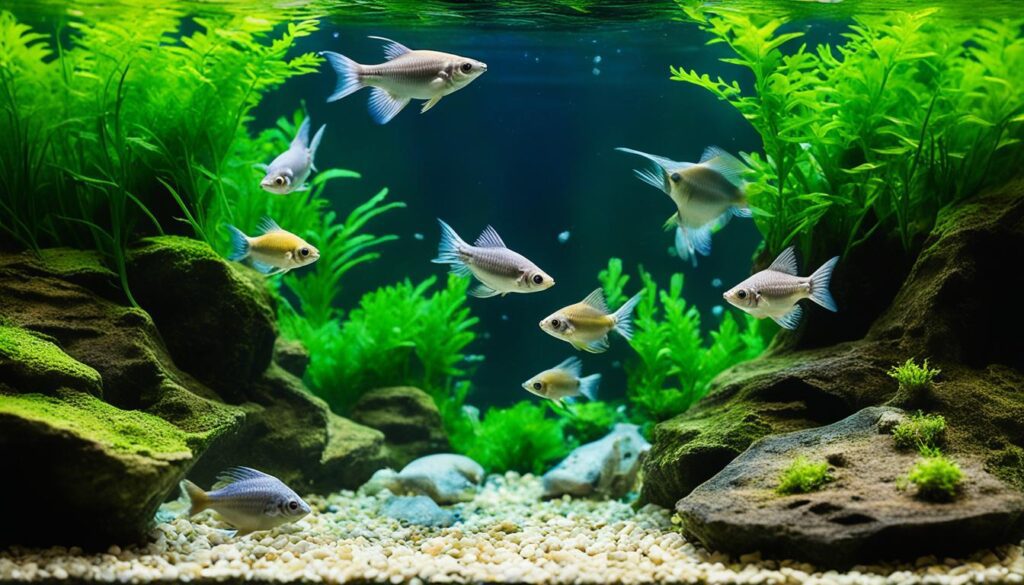
Welcome to the world of Corydoras, these armored catfish call the South American rivers home. They are loved for their unique looks and peaceful nature. This makes them great for community tanks.
Overview of Corydoras Physical Traits
Corydoras have armored bodies that make them both tough and cute. They wear bony plates for protection and have spines to keep predators away. Yet, they’re peaceful and liven up the tank floor with their movement.
The Varied Species of Corydoras
There’s a big variety within the Corydoras family, with over 150 types known. Favorites include the Bronze Corydoras, the gentle Panda Corydoras, the bright False Bandit Corydoras, and the small, quick Pygmy Corydoras.
Natural Habitat and Activity Patterns
The cory catfish live in the Amazon’s soft, acidic waters. They’re mostly active at dawn and dusk, their natural feeding times. These fish love to be in groups, where they can swim and search for food together.
We’ll look closely at these species with a table. It shows important details about their care and living needs:
Common Name |
Size (cm) |
Preferred Water Temperature (C) |
Ideal pH Level |
|---|---|---|---|
Bronze Corydoras |
7 |
22-28 |
6.5-7.5 |
Panda Corydoras |
5 |
22-25 |
6.0-7.0 |
Pygmy Corydoras |
3.5 |
22-28 |
6.5-7.5 |
False Bandit Corydoras |
6.5 |
24-28 |
6.0-7.0 |
Learning about Corydoras’ needs is key to a great fishkeeping experience. It helps these amazing South American fish flourish in your care.
The Ideal Aquarium Environment for Cory Catfish
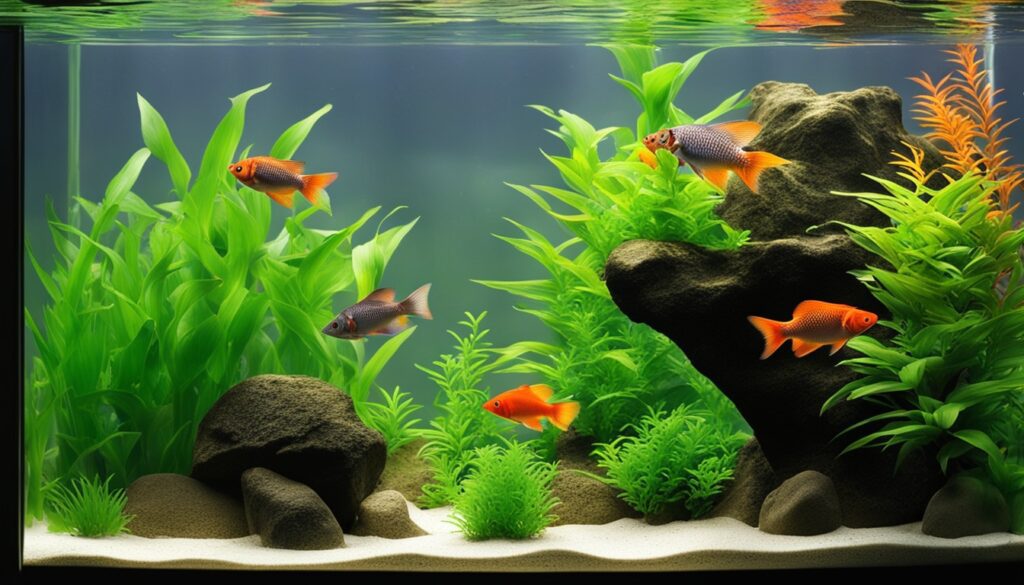
Creating the perfect home for Cory Catfish is all about knowing what they need. We’ll talk about what’s important for Cory Catfish. And how to make a tank where they can do well.
A 20-gallon tank is a good start. It’s big enough for them to be with friends but still have space to swim. Since Corydoras are calm, they fit right in with other peaceful fish.
The bottom of the tank is important for Cory Catfish. Use soft, smooth sand or gravel. This keeps their barbels safe while they’re looking for food. Sharp things can hurt them and make it hard for them to eat.
Remember, these fish like to stay at the bottom. They enjoy places to hide, like caves, and plants to explore. Keep the water at 72-78 degrees Fahrenheit and the pH levels between 7.0 and 7.8.
Make sure their tank mates are friendly. Tetras, Guppies, and Swordtails are good choices. They need the same kind of water and won’t bother the Corydoras. But keep them away from big, mean fish like African Cichlids.
Taking care of the tank is important. Change the water often to control nitrates. And always check that there’s no ammonia or nitrite.
To sum it up, a great tank for Cory Catfish has the right size, safe bottom, good friends, and clean water. Get these right, and your Corydoras will have a great life in your tank.
The Diet of Cory Catfish

Welcome to a deep dive into the diet of the charming cory catfish. Understanding their corydoras feeding guide, aquarium fish diet, and bottom feeder nutrition is key for a thriving tank. We’ll look at what they eat and how to feed them in a community tank.
Feeding Habits
Cory catfish love food that sinks to the bottom. This behavior ensures they get the nourishment they need. Unlike top feeders, they need proper meals, not just leftovers.
Suitable Foods
Their diet should be both varied and nutritious. Sinking pellets, brine shrimp, bloodworms, and daphnia are ideal. Make sure the food is small enough for them to eat easily.
Tips for Feeding in a Community Tank
Feeding corys with other fish can be hard. Feed them at night when other fish are less active. Putting sinking food in a dish can help you make sure they’re eating well.
This feeding method keeps your cory catfish and your tank healthy. A well-fed cory is a happy fish that brings life to your tank.
Behavior and Social Dynamics
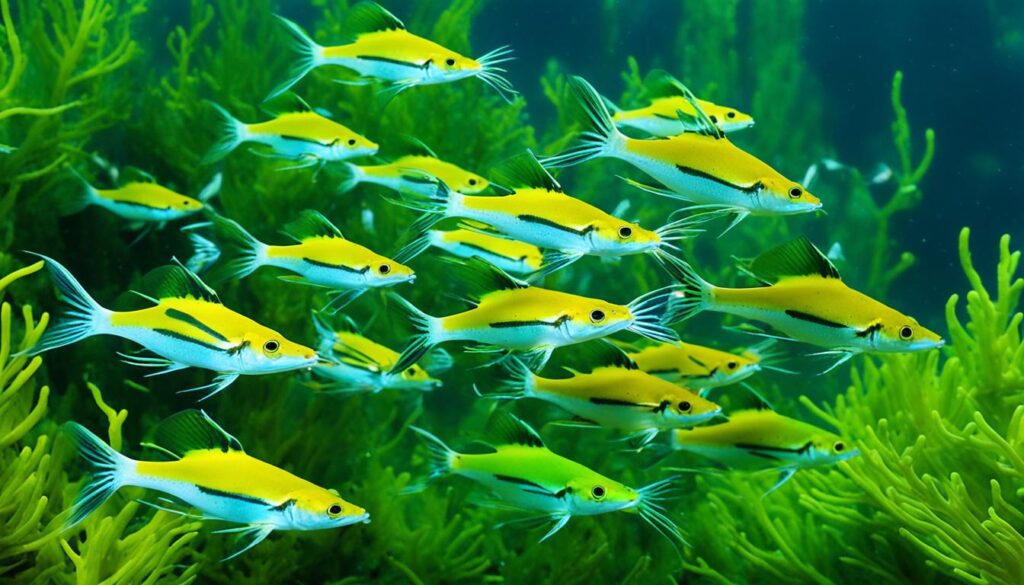
Watching cory catfish shoaling reveals their peaceful living. It highlights key parts of fish social behavior and aquatic community interactions. These little creatures are known for their calm and social ways. They show complex behaviors that are interesting to watch and learn about.
Cory catfish like to group together and swim in sync. This behavior boosts their chances of survival. It also makes a beautiful scene in the tank. Their synchronized swimming shows their community life. It also helps protect them from dangers by spreading out the risk.
Researchers have studied how they adapt to less oxygen. Cory catfish can breathe air using their gut when oxygen is low. This changes how they act with each other.
Oxygen Level |
Behavior at 25°C |
Behavior at 30°C |
|---|---|---|
100% Air Saturation |
Normal Shoaling |
Increased Air Breathing |
60% Air Saturation |
Mild Air Breathing |
Group Air Breathing |
20% Air Saturation |
Significant Air Breathing |
High Frequency Group Air Breathing |
The table shows how cory catfish adjust to different oxygen and temperature levels. It shows their teamwork and ability to handle stress. In an aquarium, how they get along with other fish matters too. They get used to touching each other. They use nudges to stay together when swimming in a group. As they grow, these nudges become more frequent. They are crucial for keeping their group together.
Learning about their social ways helps us make a better home for them. We can support their behaviors for their health and happiness. The study of cory catfish shoaling, aquatic community interactions, and fish social behavior shows the rich and interactive world they live in.
Aquarium Companion Options for Cory Catfish
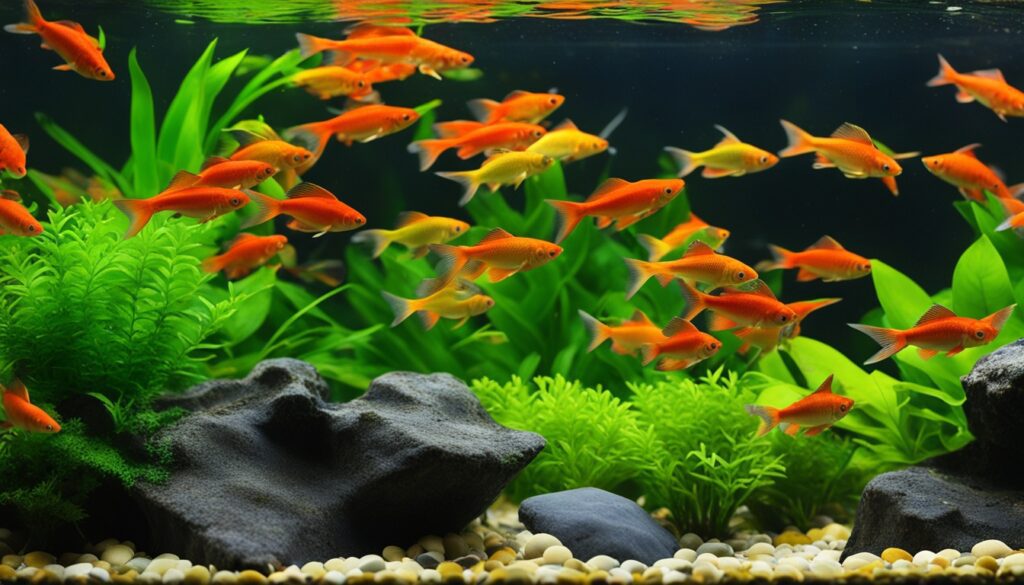
Choosing compatible buddies for your Cory Catfish is key to a peaceful and eye-catching tank. Corys are calm and do best with friends who match their vibe.
Compatible Tank Mates
It’s crucial to pick tank mates that get along with your shoaling fish. Good friends for Cory Catfish include calm and small species like Tetras, Guppies, and Dwarf Gouramis. Stay away from aggressive fish such as Cichlids. They can make Corys stressed and sick.
Schooling Preferences
Cory Catfish like being in groups for the best health and social life. Experts and personal experience say that a group of five or more is best. This makes them happy and adds beauty to your tank.
Creating a Balanced Ecosystem
For a balanced tank, it’s not just about peaceful fish. Think about what each fish needs and how they behave. Corys love soft sand and clean the tank by eating leftovers. Choosing fish that live in different tank areas makes your aquarium interesting and diverse.
In short, a great tank for Cory Catfish means picking the right friends and understanding their needs. This ensures a happy, healthy aquarium where all fish shine, creating a serene and captivating underwater world.
Breeding Essentials and Tips
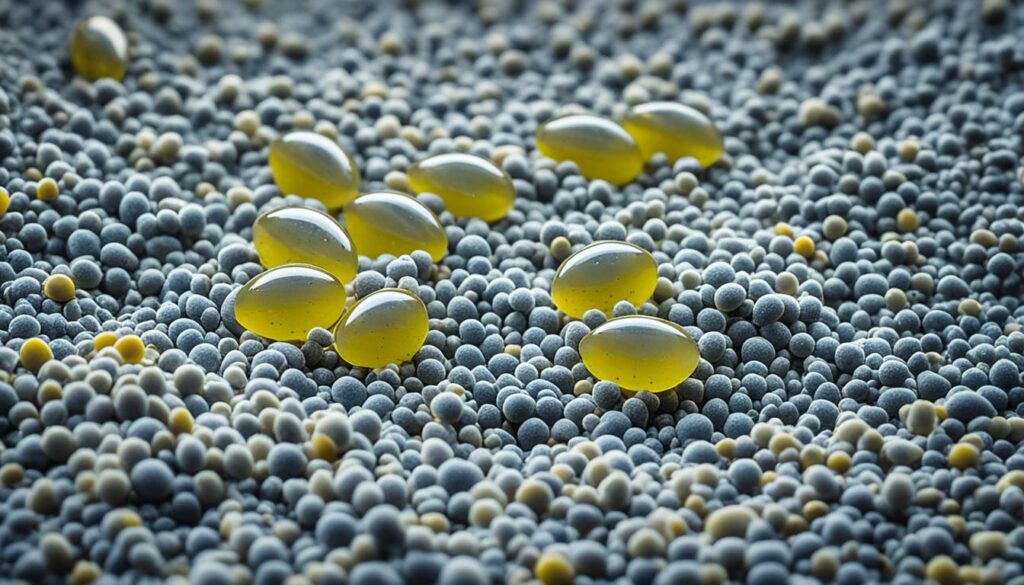
When it comes to cory catfish breeding, understanding the details helps you succeed in spawning in aquariums. If you want to breed these calm fish, knowing how to tell males from females is key. Females are bigger and wider, especially when ready to lay eggs. Males are leaner, which makes it easy to spot them before breeding.
To start breeding, you need to mimic natural changes in the environment. This usually means lowering the water temperature a bit, within the 72°F to 78°F range. This small change can encourage the fish to start spawning in aquariums. Giving them food high in protein during this time is also crucial for breeding success.
Right after the eggs are laid, taking care of them is essential. You should either move the parents to a different tank or put the eggs in a breeding tank. This keeps the eggs safe from being eaten. Putting the eggs in a tank with lots of plants or smooth stones gives them a good place to stick.
Here are some key steps for fish eggs care:
- Maintain clean water conditions to prevent fungal attacks on the eggs.
- Keep the water movement minimal to mimic the natural still water habitat of eggs.
- Feed the hatchlings with high-quality powdered fry food and newly hatched brine shrimp to ensure adequate nutrition for growth.
Successful cory catfish breeding means creating a space where the fry can grow well. The first few weeks are very important. You need to feed them twice a day. Make sure their food is fine and nutritious, so even the smallest fry can eat.
Breeding Parameter |
Recommended Condition |
|---|---|
Water Temperature |
72°F – 78°F |
pH Level |
7.0 – 7.8 |
Tank Setup |
Sand or fine gravel with dense vegetation |
Feeding Fry |
Powdered fry food, baby brine shrimp |
Water Change Frequency |
Twice weekly for breeding tank |
With proper setup and ongoing care, breeding cory catfish can be very rewarding. Each group of fry you raise not only beautifies your tank. It also helps keep these special fish thriving in home aquariums.
Lifecycle of Cory Catfish
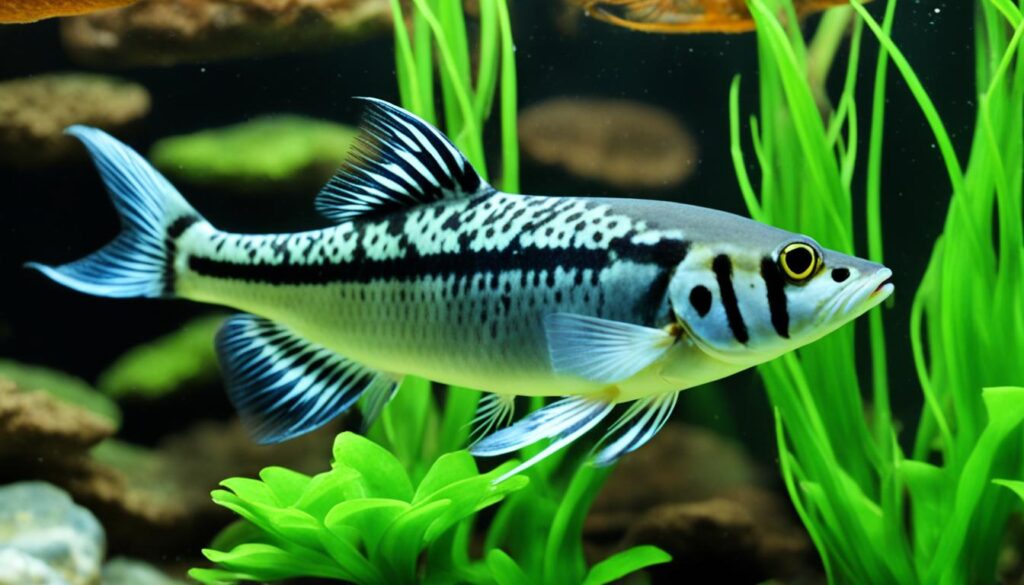
Learning about the lifecycle of Cory Catfish is crucial for anyone keeping an aquarium. This includes knowing the age of corydoras, when they mature, and their expected lifespan. Cory catfish, such as C. paleatus or peppered corydoras, live a long life and adapt well to different water environments.
Cory catfish usually mature by one year old. Their growth and lifespan depend a lot on their care, diet, and living conditions. Providing the right environment can make them live beyond the usual 5 to 10 years, sometimes up to 20 years. Corydoras paleatus can handle a wide range of temperatures, thriving in 72 to 82°F.
A good diet is key for a long fish lifespan. Cory catfish eat everything from tubifex worms to sinking pellets. Since they’re bottom feeders, a nutrient-rich diet is important for their health and growth throughout their lives.
Water quality is vital for the age of corydoras. These fish do best in a pH of 7.0 – 8.0. They can adapt to various water hardness, making them great for community tanks. It’s important to keep the water clean with regular changes to prevent harmful buildup.
Cory catfish need a certain amount of space to stay healthy. A single fish needs at least a 10-gallon tank. Groups need more space to show natural behaviors and maintain their health.
For more details on their care, check out the Cory Catfish Care Guide. It covers everything from what they eat to tank size and breeding tips to ensure your cory catfish flourish from when they’re young to their senior years.
Health Considerations
Keeping cory catfish healthy needs constant water quality care. This is because they can get barbel erosion if their space isn’t right. In my 55-gallon tank with many fish types, I make sure water conditions are ideal. This means pH at 7.2, KH at 50, and GH from 200-300. Ammonia and nitrites stay at 0, while nitrates are 10-20, keeping my fish, including 4 cory cats, happy.
“Grandpa catfish” has lived with me for 17 years. His longevity shows how well I care for my tank. But, I’ve faced issues, like when new emerald green corys got a fungus. To fix this, I used a small hospital tank with API Fungus Cure and Triple Sulfa. Following the treatment instructions carefully is key, especially with Fungus Cure’s specific Victoria Green and Acriflavin mix.
With proper care, using treatments like Mar-Oxy can heal problems caused by thread on an otto catfish’s gills. My Corydoras started to recover after 11 days of treatment, showing fin regrowth. Corydoras thrive with the right care, like being in groups of six and kept at 72 – 79°F. They can live up to 5 years. My secret is paying close attention and keeping up with tank maintenance to keep my cory catfish in good shape.







